
Hylidae is a wide-ranging family of frogs commonly referred to as "tree frogs and their allies". However, the hylids include a diversity of frog species, many of which do not live in trees, but are terrestrial or semiaquatic.

Litoria is a genus of hylid tree frogs, sometimes collectively referred to as Australasian treefrogs.
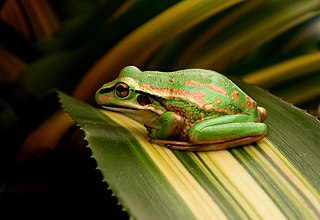
The green and golden bell frog, also named the green bell frog, green and golden swamp frog and green frog, is a species of ground-dwelling tree frog native to eastern Australia. Despite its classification and climbing abilities, it does not live in trees and spends almost all of its time close to ground level. It can reach up to 11 cm (4.5 in) in length, making it one of Australia's largest frogs.

The Australian green tree frog, also known as simply green tree frog in Australia, White's tree frog, or dumpy tree frog, is a species of tree frog native to Australia and New Guinea, with introduced populations in the United States and New Zealand, though the latter is believed to have died out. It is morphologically similar to some other members of its genus, particularly the magnificent tree frog (R. splendida) and the white-lipped tree frog (R. infrafrenata).

Ranoidea chloris, commonly known as the red-eyed tree frog or orange-eyed tree frog, is a species of tree frog native to eastern Australia; ranging from south of Sydney to Proserpine in mid-northern Queensland.

Tyler's tree frog or the southern laughing tree frog is an arboreal species of tree frog. It is native to eastern Australia where it occurs from south-eastern Queensland to the southern coast of New South Wales. It is generally a coastal species and is not found inland.
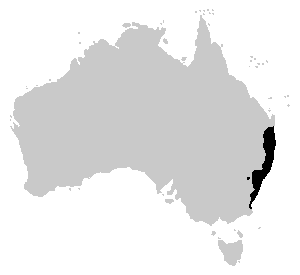
The robust bleating tree frog, also known as Keferstein's tree frog, is a species of tree frog in the subfamily Pelodryadinae. This frog is endemic to coastal eastern Australia, where it ranges from northeastern New South Wales to the NSW/Queensland border. It has also been introduced to Lord Howe Island.
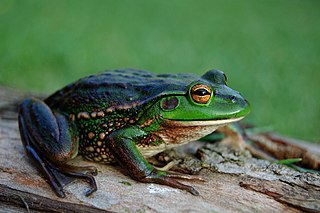
The growling grass frog, also commonly known as the southern bell frog, warty swamp frog and erroneously as the green frog, is a species of ground-dwelling tree frog native to southeastern Australia, ranging from southern South Australia along the Murray River though Victoria to New South Wales, with populations through Tasmania. This species' common names vary between states; the name southern bell frog applies in New South Wales and South Australia, growling grass frog in Victoria, and green and gold frog in Tasmania. This species has been introduced to New Zealand.
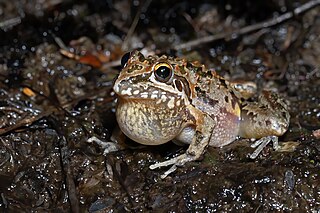
Freycinet's frog, also known as the wallum rocket frog, is a species of frog. It inhabits coastal areas from Fraser Island, Queensland, south to the Jervis Bay Territory of New South Wales.

The Jervis Bay tree frog, also known as the curry frog in reference to its odour, is a species of Australian frog associated with wallum swampland along the east coast of New South Wales; ranging from the Queensland border to eastern Victoria.
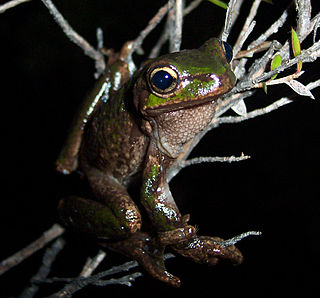
The Tasmanian tree frog, also known as king tree frog, is a species of tree frog that is found on the west coast of Tasmania, Australia. It was first found by Myrtle Burrows in 1941, at Cradle Mountain and handed over to Scott Oswald, who is attributed with the discovery.

The dainty green tree frog, also known as the graceful tree frog, is a species of tree frog in the subfamily Pelodryadinae. It is native to eastern Queensland, and north-eastern New South Wales, Australia and ranges from northern Cape York in Queensland to Gosford in New South Wales, with a small and most likely introduced population in Hornsby Heights in Sydney. It is one of two faunal emblems of the City of Brisbane.
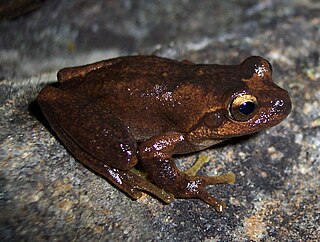
Littlejohn's tree frog, also called a heath frog or orange-bellied tree frog, is a species of tree frog native to eastern Australia from Wyong, New South Wales, to Buchan, Victoria.

Lost frogs, also called translocated frogs, frogs which have been relocated, usually accidentally, outside of their original distribution.

The motorbike frog is a ground-dwelling tree frog of the subfamily Pelodryadinae found in Southwest Australia. Its common name is derived from the male frog's mating call, which sounds similar to a motorbike changing up through gears; it is also known as Moore's frog, the western bell frog, western green and golden bell frog, and western green tree frog. The Noongar name for it is Kyooya.Note 1
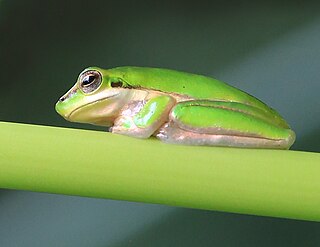
The northern dwarf tree frog is a small species of tree frog native to northern Australia, from the Kimberly region of Western Australia to Bowen, Queensland, and Aru Islands of Indonesia.
The Cooloola sedge frog or Cooloola tree frog is a species of frog in the subfamily Pelodryadinae.
The Wendessi tree frog is a species of frog in the subfamily Pelodryadinae.
Eastern tree frog may refer to:





















